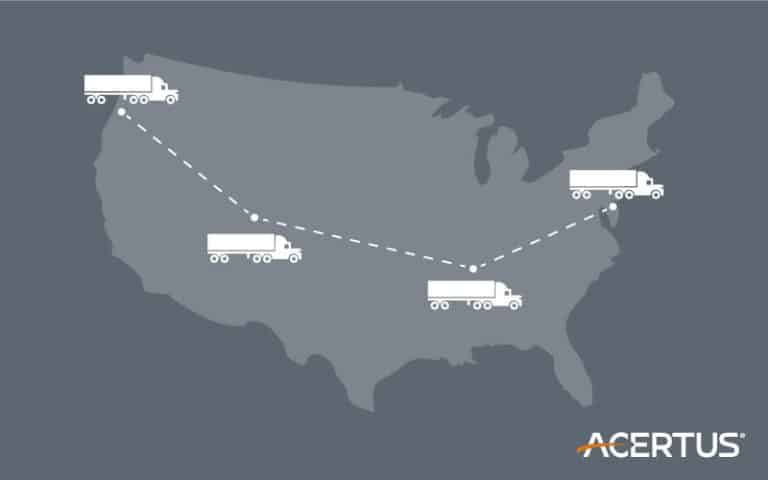Discover the meaning and importance of drayage in the logistics industry with this comprehensive guide.
Drayage Meaning and What Part Does it Play in Logistics
You may wonder what drayage is if you are a new investor in the shipping business. Drayage bridges the gaps between lengthy cross-country, international, or intercontinental intermodal hauls, and the final destination, making it a crucial component of the supply chain logistics industry. Drayage is the transportation of goods by shipping freight that entails the movement of goods from the production site to retail distribution locations.
It’s a popular term in the shipping and transportation industries. It is a misconception that only ships or airplanes are needed to convey freight—other transportation used for this service, from road-going vehicles to trucks, rail, or drayage.
In this article, we’ll take you through some of the fundamental things you need to know about drayage, mainly why it is essential, its types, classifications history—and of course, you’ll get incredible knowledge about this service.
Let’s get started…
Overview of Drayage Meaning
Drayage is transporting merchandise across a couple of miles or as part of a long journey. It is frequently referred to as the first mile since it substantially impacts forward operations, similar to the initial drop in a series. It is the vital component of the supply chain that ensures the sustainability of multimodal transportation.
Integrating the usage of trucks, railroad, and sea to carry cargo is viewed as a viable solution to fulfill shipping and freight schedule and cost demands that long-haul, over-the-road trucking fails to achieve. A drayage service usually requests moving goods by land or water, often provided by a wagon driver or team. The word de-ray, as in to unload a boat by boat, also refers to this concept. The drayman or driver is the person who drives a wagon.
Drayage consists of several things, from trucking container ships to carrying cargo across harbors to moving freight from a port to a train depot. It will begin the next leg of its voyage, with a truck employed to transport the load to its final location. The shipping and logistics industries use the term drayage to describe the practice of moving products over small distances. Although drayage is used for small-scale cargo transportation, the transshipment sector mainly uses it.
Why Is Drayage Important?
Drayage is an essential mode of transporting goods because most shipping goods are transported by truck, water, rail, or air, most of which are efficient and quick. Hence carriers choose this mode based on how risky the transport is. For example, if a shipment needs to reach a store in a hurry, air would be faster than ground transportation.
Drayage allows for a more efficient manner of carrying freight and ensures that your products arrive when and where they should. It ties together the entire container shipping process. It’s a basic mode of transportation in the industrial, military sectors, and retail businesses, thus crucial for supply chain management managers. Military bases use drayage transportation for military weapons to bases, ports, and military installations.
Drayage also transports goods for industrial plants- from factories to warehouses and ports. In addition, drayage helps supply areas affected by natural disasters or wars with necessities such as food and water.
Why Choose ACERTUS for Auto Shipping?
Whether you are shipping one car or an entire fleet of vehicles, auto shipping with an established auto shipping company with a proven track record of on-time deliveries can save you time and money. Our network of 35,000+ carriers is always ready to meet your needs. The fact that 99.7% of our orders are successful is a testament to our capabilities. Speak with an auto relocation expert today for best-in-class pricing and zero-down bookings!
Get help with auto shipping now!

Drayage Meaning in Logistics
Tracing the origins of the word “drayage,” we find that it stems from the term “dray,” which refers to a horse-drawn cart or truck without sides used to transport heavy loads. When combined with “age,” drayage refers to the fee charged for these services.
Drayage services encompass the transportation of shipments or cargo over short distances, such as from a port to a warehouse or vice versa. It also refers to the fee charged for these services.
In the logistics industry, drayage is an integral component, particularly in freight shipping where it is used for the transportation of goods from the ship to the warehouse. This also involves moving goods from the delivery vehicle to trade areas like malls or stores for manufacturers and wholesalers.
Smaller shipments can also benefit from drayage services, as it is increasingly being recognized as a cost-effective solution for eCommerce sellers. The growth of drayage in recent years is a testament to its role in the overall movement of services in the logistics industry.
What is Intermodal Drayage?
Intermodal drayage refers to the movement of containers and trailers over short distances, typically within a metropolitan area, using multiple modes of transportation. The term “intermodal” means that the shipment is transferred from one mode of transportation to another, such as from a ship to a truck, or from a rail to a truck. The term “drayage” refers to the fee charged for this movement of containers or trailers.
Intermodal drayage is an essential part of the supply chain management process and plays a crucial role in the transportation of goods from one place to another. It is often used as a solution for shipping companies and logistics providers to handle the final leg of a shipment’s journey from a port, rail yard, or distribution center to its final destination. The purpose of intermodal drayage is to simplify the movement of cargo and provide a more efficient and cost-effective solution for shipping companies and logistics providers.
Intermodal drayage involves the use of specialized trucks, known as drayage trucks, to transport containers and trailers from one mode of transportation to another. These trucks are equipped with specialized equipment, such as chassis, that allows them to pick up and drop off containers and trailers at various locations. The use of intermodal drayage is particularly important for shipments that require the use of multiple modes of transportation, as it helps to ensure that the shipment remains secure and protected during transit.
Intermodal drayage is a cost-effective solution for shipping companies and logistics providers as it eliminates the need for multiple shipments and reduces the amount of handling required to transport goods from one location to another. Additionally, intermodal drayage helps to reduce the carbon footprint of the transportation industry by reducing the number of trucks required to transport goods.
Intermodal drayage also helps to reduce the risk of damage to goods during transit. As the containers and trailers are transferred between modes of transportation, they are less likely to be exposed to harsh conditions, such as weather or rough handling, that can result in damage to the goods.
In conclusion, intermodal drayage is an essential part of the supply chain management process, providing a more efficient and cost-effective solution for shipping companies and logistics providers. It helps to simplify the movement of cargo and reduce the risk of damage to goods during transit, ultimately improving the overall supply chain management process.
Drayage Services Meaning
The purpose of the drayage service is to transport entire containers by road. This is different from LCL service. CFSs (container freight stations) deconsolidate containers based on their location into separate trailers for LCL shipping. Individual shipments are then transported on regular semitrailers.
What happens when you ship a full truckload of freight? Containers must be transported in their entirety in order to reach your company. The two most common methods are by road and rail:
If you are shipping a full container of freight, it doesn’t need to be deconsolidated. It simply needs to be picked up and brought to your door. This is one of many instances in which drayage service may be used. You can hire a drayman to pick your container up from the port and bring it to your company’s dock.
This type of drayage is only meant for short trips though. If your company is located on the coast, it may not be too difficult to find a drayman who can carry the container from the port to your dock door, so a straight port-to-drayman-to-door move may be easy enough!
But what if your company is located inland? Do you still need drayman, and what role do they then play?
Intermodal Transport: Drayage Service
Drayage service isn’t just charted service of your freight container to your door by a trucker – it’s any service required for picking up a full container and moving it to another location. In other words, if you ordered a full container of freight and need to get it to inland states, it still needs to be picked up from the port and brought to an intermodal port for rail transportation.
In this instance, you would hire a drayman to pick the container up from the ocean port and bring it to the intermodal port. The intermodal carrier would then bring your freight to its destination rail port where you would, again, hire a drayman to pick up your container and bring it to your door.
Drayage Classification Types:
Intermodal drayage services play a crucial role in the transportation industry, moving cargo from one mode of transportation to another. There are several types of drayage services that cater to the different needs and demands of the customers. Understanding each of these services can help companies and individuals make informed decisions about their transportation needs.
Accelerated Drayage
This type of drayage service is designed for those who need fast and reliable deliveries. It is a time-sensitive service that requires shipments to be delivered on the same day, making it ideal for businesses that operate under tight schedules. It is a cost-effective solution for businesses that need to deliver products quickly and efficiently.
Drayage Pier
Pier drayage is a specific type of drayage service that deals with the transportation of cargo for ocean shipping. It involves moving cargo from a rail terminal to a dock or pier, where it will be loaded onto a ship for its ocean journey. This type of service is essential for businesses that rely on ocean shipping, as it helps to ensure that cargo reaches its destination on time.
Transportation Drayage
Inter-carrier drayage is a delivery process used to transport cargo between different carriers. This type of service is ideal for businesses that need to move products from one location to another without having to transfer the cargo from one vehicle to another. Inter-carrier drayage helps to reduce the risk of damage to the cargo, as it is transported in a single container from start to finish.
Drayage From Door To Door
This common drayage technique involves delivering the container directly to the final customer by truck. This type of service is ideal for businesses that need to deliver their products directly to their customers without having to transfer the cargo to another mode of transportation. It is a convenient and cost-effective solution for businesses that need to deliver products directly to their customers.
Transient Drayage
Transient drayage is a service that involves moving cargo to two or more different hubs owned by the same carrier. This type of service is ideal for businesses that need to transfer their cargo from one location to another within the same network. Transient drayage helps to reduce the risk of damage to the cargo and ensures that it reaches its destination on time.
Transport or Shuttle Drayage
This type of drayage service is often used when the origin hub is full, to move intermodal freight units to transitory shipping locations. It is a cost-effective solution for businesses that need to transport their cargo from one location to another, without having to transfer it from one mode of transportation to another.
In conclusion, there are several types of drayage services that cater to the different needs and demands of the transportation industry. Understanding each of these services can help companies and individuals make informed decisions about their transportation needs and ensure that their cargo reaches its destination on time and in good condition.
History of Drayage
Drayage originally came from Middle English, derived from the Old French word drayage, which means shipment. In the 14th century, the French word transport was also incorporated into English. Over time, the two terms came together to form transport, and as this happened, ‘dr’ also became part of the transport, leading to ‘drayage-transport’ being used, which was shortened to ‘transport.
Ultimately, there is no longer any dispute that transport is derived from the Old French term ‘drayage. The word’s initial meaning was “to convey by the side less cart” or “dray.” Due to a dray horse’s limitations, wagons could only transport products over small distances. Most dray activities occurred in marine ports before extending to canals and railway ports. The quasi-loader eventually took the position of the horse.
Conclusion
Drayage services are crucial even if they only make up a minor portion of the shipping problem; hence there must be proper execution of the first mile, which entails good drayage. It involves various methods and modes of transportation used in the intermodal shipping process to move your merchandise from one location to another.
Get help with auto shipping now!
Drayage FAQs
Some of the frequently asked questions by people new to this term include:
1. Do hauling costs exist, and how are they implemented?
Yes, there are a variety of expenses, including dropping fees, that are usually charged whenever a truck collects your cargo container at the delivery location.
2. Do risks related to drayage emerge?
drayage entails some risks like there can be problems with customs clearance or a lack of carrier capacity when your ship





